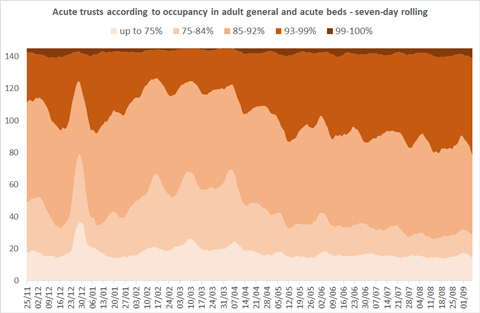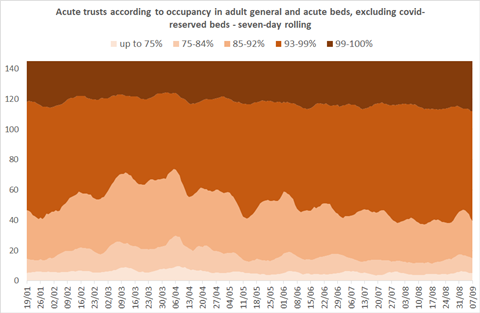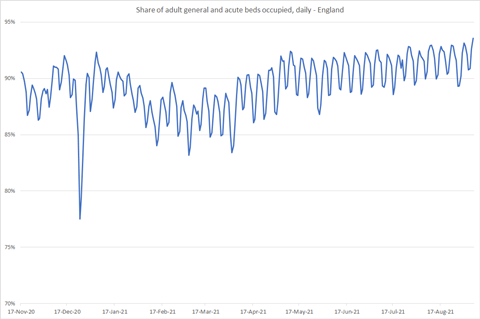The number of acute trusts running at very high bed occupancy hit a new peak last week, with nearly half of acute trusts over NHS England’s 92 per cent benchmark, analysis shows.

Hospitals, ambulance services and general practice have reported what they say is unprecedented pressure for this time of year.
Medical royal colleges have said 85 per cent is a maximum safe bed occupancy, while NHS England has previously advised trusts to try to stay below or at 92 per cent.
But last week nearly half of acute trusts (67, or 46 per cent) were operating at more than 92 per cent occupancy in adult general and acute beds, with the figure having risen persistently since March (see chart left).
The number of trusts at an extremely high level (99-100 per cent) on a rolling weekly basis was also at a high point of six trusts last week.

The figures are even higher still if beds which are being reserved for covid patients are discounted — giving an effective occupancy level for non-covid care. On this measure, more than 100 acute trusts, or nearly three in four trusts, are operating at 93 per cent occupancy or above (see chart right).
Occupancy in adult general and acute beds across England hit 94 per cent last Tuesday (7 September), the highest since November 2020 when public reporting began.
Directly comparable figures are not available but quarterly reports record the highest occupancy across all G&A beds as 92.6 per cent in the first three months of 2018.
On 7 September, there were eight trusts whose average daily occupancy in adult G&A beds over the previous seven days was 99-100 per cent. These were: Milton Keynes University Hospital, Calderdale and Huddersfield, Surrey and Sussex, University Hospitals Coventry and Warwickshire, Walsall Healthcare, North Middlesex University Hospital, Southport and Ormskirk Hospital, and North West Anglia.
NHS Providers deputy chief executive Saffron Cordery said: “Different research shows hospitals work most safely and effectively at bed occupancy of 85 per cent and no higher than 92 per cent.
“It’s really worrying that a growing proportion have significantly higher occupancy levels. This can have a direct impact on their ability to provide safe and timely care for patients.
“Treating patients quickly and effectively depends on having the right number of beds. We need the NHS to be resourced properly which is why it’s so important the health service gets the immediate funding it needs for the second half of this financial year and in the upcoming comprehensive spending review.”
Hospital managers who spoke to HSJ cited several reasons for the current pressure, including the number of admissions and severity of illness, problems discharging into care services, linked to staffing, and reduced numbers of beds, linked to infection control measures and lack of workforce.
One hospital chief executive in the North of England, speaking to HSJ, said: ”This is the most pressurised summer I’ve ever experienced and it’s due to a combination of staff shortages especially in the care sector and activity.”
A chief operating officer in the South said: ”We had the most difficult August bank holiday on record… What’s crippling is at the moment is the acuity of patients coming in to [the emergency department] and being admitted.”

Source
HSJ analysis
Source Date
September 2021



























5 Readers' comments